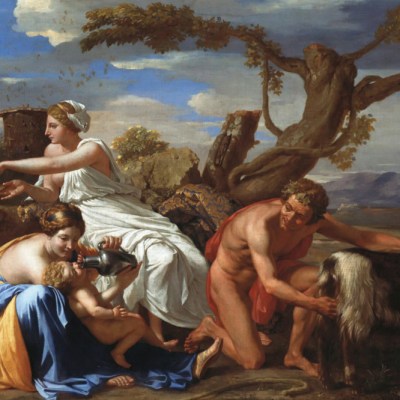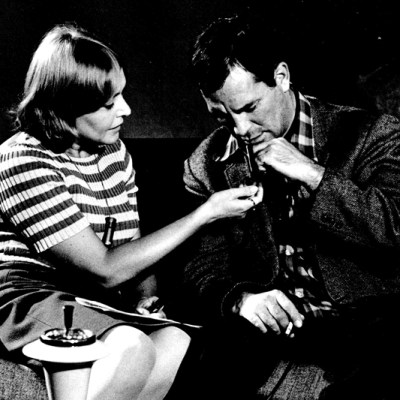Bob Thompson, who was born in Louisville, Kentucky in 1937 and died in Rome only 28 years later, made paintings that raise questions about what the traditions of art are for. ‘I went to Europe, the museums were driving me crazy.’ That’s Thompson, speaking in the mid 1960s. ‘I was seeing so much art […] my God, I look at Poussin and he’s got it all there.’ Thompson and his wife Carol Plenda lived in Europe twice: first from 1961–63, then again from 1965 until his death the following year. The encounters with Old Master paintings that drove him so crazy informed the works for which Thompson has become well known: allegorical scenes with multiple figures in silhouette, each rendered in flatly executed, jarring, dazzling colour. A striking example, Perseus and Andromeda (1964), which plays on Titian’s painting of the same name, is currently on show in the small exhibition ‘Measure of My Song’, at Maximillian William, London (until 13 December). Yet what he did with those traditions remains elusive. His paintings neither appropriate nor mimic the work of the artists he loved but somehow revitalise them. They use Old Master painting as a medium in and of itself, mounting a case for its vitality by speaking through it.


Thompson’s painting The Execution (1961) does just that. Figures assemble in a clearing. On the left, a standing group, done in flat fields of pearly greys, ochre, and brick red, look across at the event taking place on the right: a scene of decapitation. Bodies sprawl on the ground; severed heads tumble. The composition derives from Fra Angelico’s predella panel The Beheading of Saint Cosmas and Saint Damien (1425–50) and seems to take that work’s weave of decorative colour and shocking violence as a cue. In Thompson’s translation of Angelico, the figure of Cosmas (bound and blindfolded, awaiting death) is elevated; the blindfold becomes a noose; the figure is entirely black. It’s the channelling of the older painting that grants Thompson’s work its strange temporality, siting contemporary horror within a centuries-long history of violence. Yet The Execution is, like Angelico’s Beheading, oddly reserved too; its emotional temperature is cool despite the heat of its palette. The artists to whom he most frequently turned – Angelico, Piero della Francesca and, above all, Poussin – share that reserve.

Like other Black American artists of the 20th century, including his precursor Romare Bearden and, later, Robert Colescott, Faith Ringgold and Kerry James Marshall, Thompson dug into the history of European art with abandon, transforming historical tropes into forms able to speak with urgency to their political moment. In the 1950s, while living first in Provincetown, Massachusetts, and then New York, his social world included post-Abstract Expressionist figurative artists including Larry Rivers and Red Grooms, and prominent intellectuals such as Allen Ginsberg and Amiri Baraka, both of whom he painted. Most significant, perhaps, were his encounters with musicians, as celebrated in his work Garden of Music (1960), made shortly before his move to Europe. In the painting, schematic portraits of free jazz pioneers Ornette Coleman, Don Cherry and John Coltrane, among others, are arrayed in a Gauguin-esque landscape of lush colour, like bit parts in a bacchanal. Perhaps Thompson’s relationship to Old Master painting wasn’t so far from the dissembling and reconstituting of existing music in a piece such as Coltrane’s ‘My Favourite Things’ (1961), his free rendition of the number from The Sound of Music. This improvisatory, performative approach has roots, too, in Thompson’s participation in ‘happenings’, in one of which, Red Grooms’s The Magic Train Ride (1960), he rolled a baby carriage full of tree branches across the stage to evoke a passing landscape. It sounds like an event from one of his paintings.

Thompson’s encounters with Poussin’s work rewarded him with strategies that he seemed to draw on repeatedly. This was not simply a matter of the coherent arrangement of bodies in space: it manifested too in the intervals between those bodies, which add up to a kind of compositional pattern that is close to abstraction. In Thompson’s Homage to Nina Simone (1965), Poussin’s Bacchanal with Guitar Player (c. 1625) is subjected to a transcription that smooths out the complex textures in the latter painting in favour of an interlocking sequence of brightly coloured zones, like an embroidered quilt. It’s a matter of editing and enhancing. Figures in the Poussin shed clothes in the Thompson, lose the markers of gender, turn bright blue, red or yellow; iconographic details (vine leaves, grapes, plates and cups) are shorn away; negative spaces go from deep shadow to intense vibrancy. The painting’s title may allude to Thompson’s replacement of a male bacchante in the original with a nude female figure whose tall coiffure resembles the singer, composer and activist’s mid-1960s hairdo. There’s some kinship in Thompson and Simone’s ambivalent, searching approaches to their chosen mediums. In 1976, Simone performed at the Montreux Jazz Festival, covering the saccharine hit ‘Feelings’ by the Brazilian singer Morris Albert. Her rendition is at once tender and sardonic, questioning the sincerity of the original while, maybe even despite herself, producing something beautiful (go listen). Whatever Thompson’s attitude was to Poussin, Angelico and others, it may have been something like that. In his hands, the traditions of art become a means of thinking through how bodies coexist in shared spaces, and what happens when they can’t, or won’t. ‘In a certain way,’ he once said, ‘I am trying to show what’s happening, what’s going on […] in my own private way.’


‘Measure of My Song: Bob Thompson’ is at Maximilian William, London, until 13 December.


